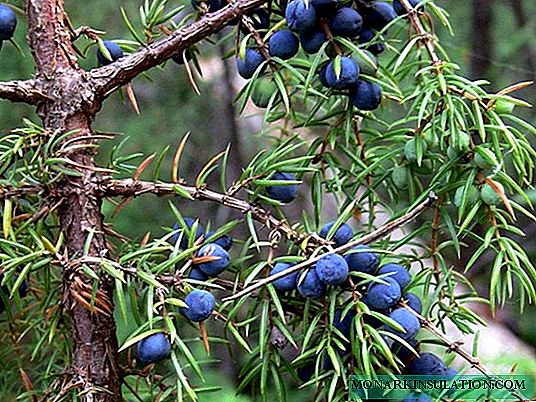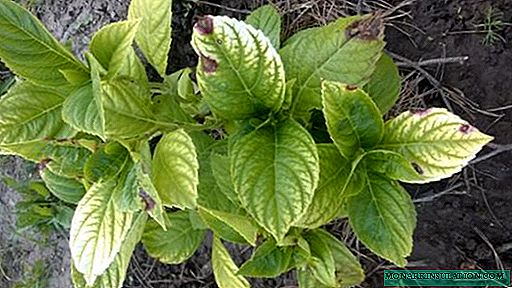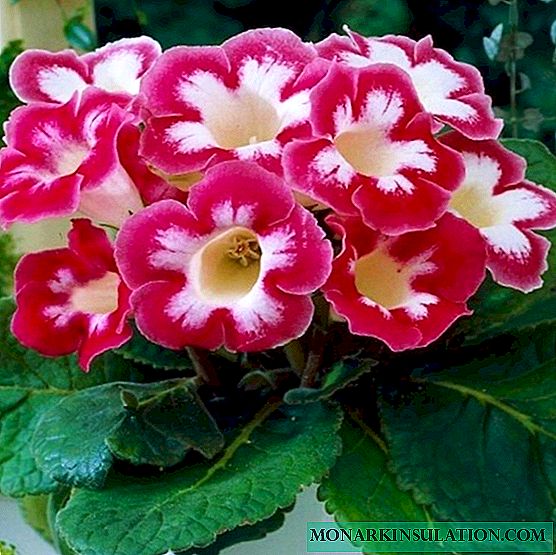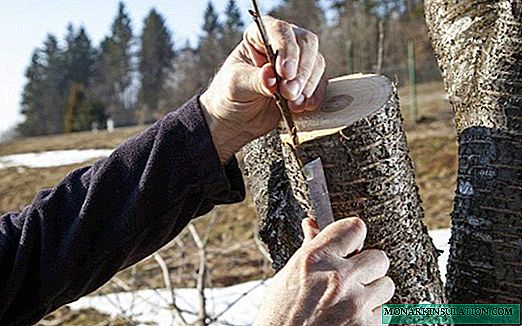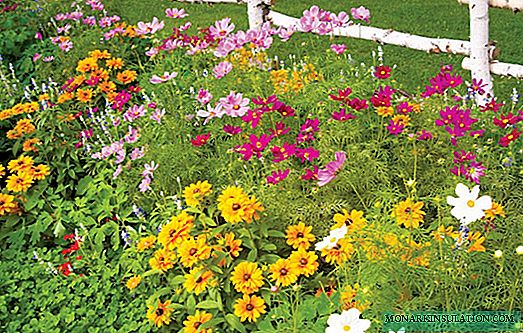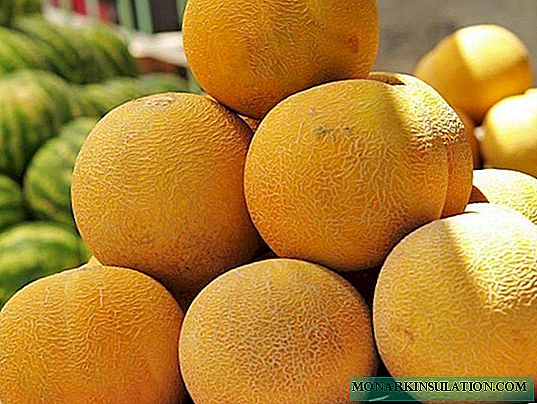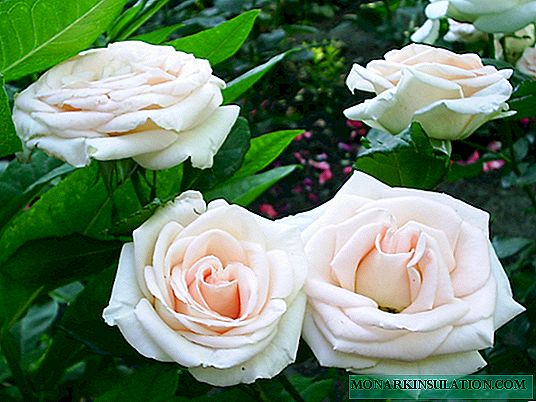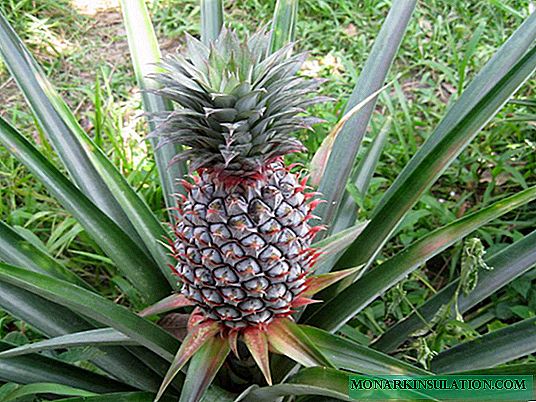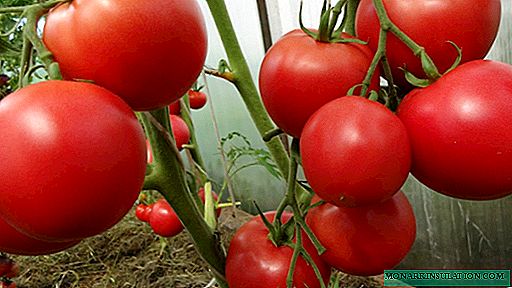
Tomato is one of the gardeners' favorite vegetables and many dream of tasting fresh fruits as early as possible. Breeders receive all new varieties that differ in very early ripening. Lyubasha, an ultra-early hybrid of domestic origin, also belongs to such early tomatoes.
Description of the variety Lyubasha
Lyubasha hybrid tomato was received recently, in 2016, by the Russian breeders of the Partner agricultural firm. Since 2017, the variety has been in the State Register and is recommended for cultivation in open ground and in hotbeds throughout Russia.
The hybrid belongs to early ripe tomatoes and is characterized by excellent taste. From the emergence of seedlings to harvesting takes only 70-85 days (taking into account possible changes in the ripening dates in various climatic conditions).
Tomato Lyubasha on video
Appearance of plants
Lyubasha refers to determinant tomatoes, that is, is limited in growth. The maximum "growth" of the bushes is 1 m. The plants are compact, have an oval shape. The stems are strong, which allows them to tolerate the heaviness of the crop. The number of leaves on the bushes is medium, the size of the leaf is small, the color is dark green. Inflorescences are simple, usually 4-5 fruit brushes are formed on each bush.
The medium size (average weight 120-140 g), the fruits are characterized by a rounded, slightly flattened shape and medium ribbing. The skin is smooth and glossy, fairly dense, so that the tomatoes do not crack even in rainy weather.

Lyubasha bushes do not grow too big
At the stage of technical ripeness, the peel has a pale green color, and when fully ripened, it is saturated bright red. The pink flesh is characterized by medium density and high juiciness. Each fruit has 3-4 rather large (compared to other hybrid tomatoes) seed chambers, but the total number of seeds is not too large.

The size of the tomatoes reaches 6-7 cm, and the number of large seed chambers is usually 3
Juice and pulp contain a large amount of B, C, PP vitamins, as well as potassium, phosphorus and other useful elements. The content of ascorbic acid is as high as in citrus and black currants. The consumption of fresh tomatoes is recommended to improve metabolism and as a support agent for anemia, cardiovascular diseases, memory impairment and other diseases.
Taste of tomatoes Lyubasha receives high marks from experts. A bright aroma is also noted, especially when cutting fruit.
Advantages and disadvantages, features, differences from other varieties
Despite its recent history, tomato Lyubasha often receives praises from gardeners due to a number of advantages such as:
- early germination and very early ripening;
- high productivity (2-2.5 kg from one bush in open ground and up to 4 kg in a greenhouse or 8-10 kg / m2 and 15-20 kg / m2 accordingly);
- resistance to weather vagaries and lack of care;
- lack of need for regulation of growth;
- good resistance to pests and diseases (in particular, late blight, tobacco mosaic and gray rot);
- the possibility of transportation and long-term storage due to the dense skin;
- good taste (rare for early types of tomatoes);
- universality of use (well suited for both preservation and fresh consumption).
Disadvantages:
- poor resistance to prolonged temperature decrease;
- uneven size of the fruit: the first tomatoes reach a mass of 200 g, and then they are ground;
- the need for tying (despite limited growth) and pinching;
- simultaneous ripening of the crop, which does not allow for a long time to enjoy fresh fruits.
Unlike most other varieties Lyubasha does not require top dressing during the growth period.
There are a lot of early varieties and hybrids of tomatoes, so for comparison with the Lyubasha hybrid, we will consider only some of them.
Table: Comparative characteristics of the Lyubasha hybrid and some other early tomato varieties
| Indicator | Variety / Hybrid Name | ||||||
| Lyubasha | Alpha | Aphrodite F1 | Benito F1 | Greenhouse precocious F1 | Golden brush | Legionnaire F1 | |
| Ripening time | 70-75 days | 87-96 days | 75-80 days | 95-113 days | 80-90 days | 95-98 days | 90-95 days |
| Height | up to 100 cm | 40-50 cm | 50-70 cm | 40-50 cm | Up to 70 cm | Up to 150 cm | 45-60 cm |
| Fetal size | 110-130 g | 50-70 g | 110-115 g | 120 - 140 g | 120-180 g | 20-30 g | 140-150 g |
| Productivity | Up to 15 kg / m2 | Up to 6.5 kg / m2 | Up to 17 kg / m2 | Up to 25 kg / m2 | Up to 15 kg / m2 | Up to 6.5 kg / m2 | Up to 17 kg / m2 |
| Preferred Growth Method | greenhouse / outdoor | greenhouse / outdoor | greenhouse / outdoor | greenhouse / outdoor | greenhouse | greenhouse | greenhouse / outdoor |
| The need for seedling preparation | required | not required | required | required | required | required | required |
| Main advantages | Unpretentious to growing conditions, resistance to apical rot | Undemanding to heat and light, the minimum requirements of agricultural technology | lightness, transportability, increased resistance to fungal diseases | resistance to verticillous wilting and fusarium, stamina | stable yield, resistant to verticillosis and fusarium | great taste | lack of fruit cracking, increased resistance to the tobacco mosaic virus |
| Appointment | universal | salad | universal | universal | universal | universal | salad |
Lyubasha grows and develops beautifully in the open ground, in greenhouses and even on the balcony in a city apartment. It should be borne in mind that the greatest yield can be obtained in greenhouse conditions.
Features of planting and growing tomato Lyubasha
Although Lyubasha belongs to the early varieties, it is usually grown by seedlings. Direct sowing in soil is possible only in the southern regions.
The timing of sowing seeds for seedlings depends on the climatic conditions of the region and can vary from mid-February to mid-March. Suitable time for sowing is calculated based on the need to transplant seedlings to a permanent place approximately 40-45 days after seed germination. It should be borne in mind that planting in the soil can only be carried out after the end of the season of return frosts.
Seedling preparation
Lyubasha tomato seeds before planting on seedlings need to be processed for the prevention of diseases. They are poured for 2-3 minutes with a weak solution of potassium permanganate, and then washed with warm water.
Step-by-step procedure for sowing seeds:
- Preparation of containers: for growing seedlings, pots, boxes, cassettes, cups, peat tablets and even plastic bags are suitable. They are filled with turfy soil, peat mixtures or humus soil.
- The soil is shed with warm water 1 day before planting.
- They make indentations 1-1.5 cm in the soil and plant the seeds. When row seeding in long boxes, the distance between adjacent holes should be 3-4 cm. When planting in separate pots, 2 seeds are placed in each hole.
- Sown containers are covered with plastic wrap (it is convenient to use food stretch film) and placed in warm (temperature + 23 ... +25 aboutC) A well-ventilated area.
- The film is removed from the crops after emergence. From the second week of life, plants need to be moved to a cooler room with a temperature of 19-20 degrees.

When sowing, the following procedure is followed: 1 - disinfect seeds with potassium permanganate; 2 - select containers and fill them with moist nutrient soil; 3 - to plant seeds to a depth of 1-1.5 cm; 4 - cover the crops with a film
Take care of the seedlings of the hybrid as well as the seedlings of other varieties of tomatoes. One of the points is the duration of daylight hours 10-12 hours (adjustable by means of additional illumination).

Phytolapms provide the light needed for plants spectrum
You need to water young tomatoes at first once a week (the frequency of watering is controlled by the degree of drying of the soil), and after 3 weeks of growth, you need to switch to moderate watering every 4-5 days. Tomatoes can not stand strong overmoistening, so care must be taken not to overfill the plants.
When a second true leaf appears in young plants, a pick should be made (for Lyubasha it is best to do this without tearing off the main root) in a larger container, for example, in pots of 0.5-0.7 l.
A distinctive feature of the Lyubasha hybrid is that it does not need additional nutrition at the seedling growth stage. If there are doubts about the quality of the soil used, a little phosphorus-potash or complex fertilizers can be applied with irrigation water.
Outdoor landing
After about 1.5 months from the moment of germination, the seedling bushes usually grow to 20-25 cm in height, already have a rather strong stem and 7-9 leaves. As a rule, by this time the first flower brush is already forming. In this state, seedlings can be planted in open ground or in a greenhouse. A transplant can only be carried out when the threat of night frost has passed. This usually happens in late May.
For tomato beds, you need to choose the sunniest spot on the site, which is lit for the longest time. Almost any soil is suitable - Lyubasha is not too picky.
When planting, it is often recommended to put fertilizer into the wells. If this is done, the tomatoes will only grow greens. Therefore, adding organics and urea to the wells is not recommended. It is better to use potassium salts or ash.
The density of planting of Lyubasha tomatoes should be 4-6 bushes per square meter (the interval between neighboring plants is 30-40 cm). So that the bushes do not fall to the ground during fruiting, it is better to immediately tie them to the stakes.
Plant care
Lyubasha is not capricious and does not require special care techniques. Nevertheless, to ensure a good harvest, it is required to perform such standard operations as weeding, hilling, watering, forming bushes, top dressing, and disease prevention.
Bushes
Due to the fact that Lyubasha is limited in growth, she does not need to be pinched: a fruit brush is formed at the top of the main shoot. Although the bushes are not too tall, they require garter and pinching (removal of lateral shoots).
Optimum yield indicators are achieved when the Lyubasha bushes are formed in 2-3 stems (with a tight planting 2 stems, with a rare plant - 3).
When maintaining a plant in 2 stems on the bush, the main shoot and one side shoot, growing under the first flowering brush, are left. The remaining side shoots must be regularly removed.
When forming in 3 stems, they act in a similar way, but leave another one growing above the first flowering brush.
Tomato formation - video
It should be noted that in the warm southern regions you can leave a greater number of stepsons.
As the bush grows, it is necessary to tie up. Despite the strength and thickness of the stems during the ripening of the fruit, the bushes can break, as a feature of the hybrid is the simultaneous ripening of tomatoes. For garter, you can use rigid trellis, stakes, twine.
Tying Tomatoes - Photo

- Twine is most convenient to use in a greenhouse, but you can also use it for planting in open ground
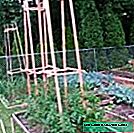
- Stable and durable structures provide reliable support for bushes

- Providing each plant with an individual support stake is a time-consuming process
Top dressing
Before planting, Lyubasha tomatoes can not be fed (although, if desired, phosphorus, magnesium, potassium compounds can be added already in the first week of growth).
Usually, the best fertilizer for garden crops is manure. For tomatoes, including Lyubasha, manure and bird droppings should not be used. Experienced gardeners prefer to use only mineral fertilizers when growing tomatoes: Phytosporin, Glyokladin, Kristallon, Lignogumat, Boroplus. From folk remedies, ash is perfect. Top dressing is carried out several times a season.
The author’s personal experience in growing tomatoes shows that it is very useful to “stress” them to prevent the fatliquoring of plants. Once the rapid growth of the bushes begins, gently reduce watering or remove one or two lower leaves. Such measures force plants to direct their forces to laying flower brushes and the formation of fruits. In addition, care must be taken with top dressing. After planting, you can’t feed the tomatoes with nitrogen (unless there is a clear deficit). It is advisable to give the first root top dressing (and potash) only by the time of flowering of the 5-6th brush. Foliar top dressing with magnesium solutions and other trace elements works well on plants. Fruits ripen better and faster on soil poor in organic matter. Therefore, you should not get involved in organic matter when preparing the soil, and during planting, you can not lay manure in the holes. In addition to fat loss, excessive organics provokes diseases of tomatoes with late blight. In general, tomatoes are better grown with malnutrition than with overfeeding. Mullein solution should not be used more often 2-3 times per season.
With an excess of nutrients, tomatoes can very easily begin to fatten. To prevent this from happening, you can take the following steps:
- Soil should not be too nutritious. Even in autumn, it is not recommended to introduce manure into the soil.
- Do not water the tomatoes during the first 2-3 weeks after planting (especially if planted early). Rooting seedlings provide water poured into the holes. Further limitation of watering contributes to the active development of the root system. It is absolutely forbidden to overdry the soil - flowers may crumble, therefore, with limited watering, care must be taken.
- Do not give tomatoes nitrogen fertilizing during the entire growing season.
Watering plants
Tomatoes for regular growth and fruit formation require regular soil moisture, especially in hot weather. Watering should be carried out strictly under the root in the evening or in the early morning. The best option is to use drip irrigation.

Drip irrigation of tomatoes you can organize yourself
The recommended regimen for Lyubasha tomatoes is watering every 5-7 days, and in extreme heat every 3-4 days. The moisture supply rate is 4.5-5 liters per 1 bush. More frequent and too plentiful watering will only harm the plant.
Frequent moderate watering of tomatoes provokes the growth of the superficial root system, which reduces the resistance of plants to adverse external factors.
2-2.5 weeks before harvesting, watering should be stopped.
Protection of tomatoes from diseases and pests
Despite Lyubasha’s high resistance to diseases and pests, there is always a risk that the plants will still get sick. The simplest means of prevention are:
- compliance with crop rotation requirements;
- timely elimination of weeds and plant debris from the site;
- plant tomatoes away from the beds with eggplant and potatoes;
- maintaining the distance between the bushes.
For the prevention and treatment of fungal and bacterial diseases, the biological preparations Alirin or Gamair are well suited.
To repel pests, it is recommended to plant marigolds around tomato beds.
Harvesting, storage and use of crops
Fruits can begin to be harvested in the last decade of June - early July. Thanks to friendly ripening, they can be cut with whole brushes.

Tomatoes ripen with brushes, which simplifies harvesting
Keep collected tomatoes in a cool dark place at a temperature of 10-12 aboutC and regular airing. Under such conditions, unripe fruits can be stored for about 2-2.5 months. Ripe harvested fruits retain their qualities in the refrigerator for up to 1 month.
Due to its good taste, Lyubasha tomatoes can be used both in salads and for various preparations. The small size of the fruit provides the convenience of pickling. They also make very tasty juice, excellent adjika and other sauces.Lyubasha tomatoes can even be sluggish.

Thanks to the dense pulp, Lyubasha tomatoes are well dried
Reviews gardeners
I bought Lyubasha hybrid, having bought at early maturity - 75 days !!! from shoots, suddenly, it turns out to be true. God grant that information about Lyubasha F1 would be at least half consistent with the description.
Aleksander//www.tomat-pomidor.com/newforum/index.php/topic,6652.msg1009053.html?SESSID=8onjafqbbps0ccnu6sv4dak7m6#msg1009053
In OG this year, I’m only mocking the Lyubasha hybrid. I don’t cut, I don’t field and generally abandoned it. Well, only in June Profit sprinkled with hunger and all. While alive and (pah-pah-pah) healthy. Quite a normal tomato-sour taste. The skin is dense. For workpieces, probably the most it. For a salad, I would not recommend
White and fluffy//www.forumhouse.ru/threads/403108/page-106#post-19677186
Tomato Lyubasha F1 is really very good, determinant, can be grown both in the greenhouse and in the exhaust gas. Recommended to grow in 2-3 trunks, the rest is removed, this is more than enough. Friendly ripening, fruits aligned. On the official website of "Partner" you can watch an informative video of agronomist Fursov N.P., where they talk in detail about Lyubasha.
Dzena1372//www.forumhouse.ru/threads/384489/page-65#post-17877239
I planted Lyubasha, who came up with difficulty - I’m not enthusiastic about them, on six bushes 2-3 of the whole brush with fruits, tall over 1, 2 meters, the bushes are very modest, nothing promised from the promised, it’s a pity that I didn’t correspond to your stories, next year I’ll try to plant again and if the same result is anymore I won’t contact the Partner company again - I’m sorry for both money and my work
Galina vishnyakova//otzov-mf.ru/tomaty-f1-otzyvy/
I and many others bought Lyubasha, Lustica. Very good hybrids
Lyudmila63//www.forumhouse.ru/threads/403108/page-198#post-20718543
Hybrid Lyubasha unpretentious to growing conditions and resistant to disease. The cultivation of the forces of even not too experienced gardener. Subject to simple rules of care, this tomato will give an early harvest of delicious tomatoes.




